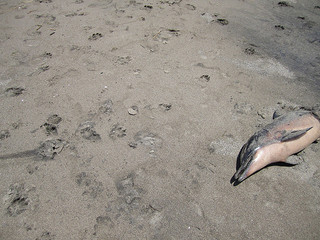Virus Blamed For Hundreds Of Dolphin Deaths

This summer, experts estimate that seven times the usual number of marine animals have had their carcasses washed ashore.
In the past two months, 357 dead or nearly dead dolphins have been reported along the shores from New York to Virginia. Experts predict that the number dead is much greater in actuality.
Scientists have recently attributed the mass die-off to a measles-like disease called cetacean morbillivirus.
“We are now calling this a morbillivirus outbreak that extends currently from New York through Virginia for confirmed cases," said Teri Rowles, the director of marine mammal health for the National Oceanic and Atmospheric Administration’s fisheries service.
Tests have identified the virus as at least a potential cause of death among 32 of the 33 dolphins tested.
The virus may continue raising the dolphin fatality rate until next spring according to Rowles.
In a similar outbreak of the virus in 1987-88, 700 bottlenose dolphins washed up along the shores. This has led experts to assume that the disease may intensify as it begins to spread southward, threatening hundreds of more dolphins.
It is also possible that chemicals, disease-causing microbes, biotoxins, and other environmental factors may have weakened the dolphins’ immune systems, leaving them more vulnerable.
The fatality spike among dolphins across the eastern seaboard “is really not surprising if you understand how the population of dolphins works,” according to W. Mark Swingle, the director of research and conservation for the Virginia Aquarium and Marine Science Center.
For any given population, “when the collective immunity drops below a certain, critical point, which we don’t really know for marine mammals, then the whole population becomes susceptible,” said Jerry Saliki, a virologist at the University of Georgia.
So far there is no evidence that the disease can spread to other species, but more tests are being run to yield more definitive results. Nevertheless, authorizes are recommending that people keep their distance from the stranded dolphins.



